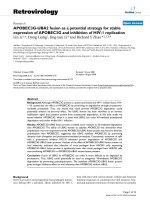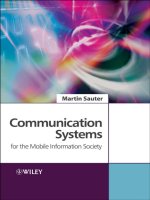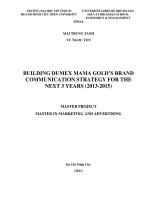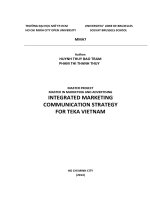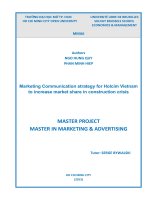Communication strategy for number 1 strawberry energy drink
Bạn đang xem bản rút gọn của tài liệu. Xem và tải ngay bản đầy đủ của tài liệu tại đây (1.01 MB, 81 trang )
MINISTRY OF EDUCATION AND TRAINING
UNIVERSITY OF ECONOMICS HOCHIMINH CITY
TỐNG THỊ MỸ HẰNG
COMMUNICATION STRATEGY FOR
NUMBER 1 STRAWBERRY ENERGY DRINK
MASTER’S THESIS
In
Business Administration
Ology code: 60.34.05
Supervisor
Dr. NGUYỄN THỊ MAI TRANG
Ho Chi Minh City 2010
i
Acknowledgement
Firstly, I would like to express my heartfelt gratitude to my tutor, Dr. Nguyen Thi
Mai Trang for all her guidance, valuable advices, comments and suggestions when I
was conducting the survey and writing my dissertation. Thank you for sparing time
to review my report even though it was a tight schedule for you and me.
I am sincerely grateful to all the survey respondents and interviewees who have take
precious time off to allow me to conduct the study and gain insights into consumer
perception and response.
I would also like to express my deepest appreciation to all my friends and family for
their unwavering support and faith in me.
Lastly, I would like to thank everyone else who has helped me in one way or
another in making this project possible.
Thank you so much.
Ho Chi Minh City, Oct 25th, 2010
Tong Thi My Hang
i
TABLE OF CONTENT
Acknowledgement .................................................................................................. i
LIST OF FIGURES ............................................................................................. vi
LIST OF TABLES .............................................................................................. vii
LIST OF GRAPHS ............................................................................................ viii
CHAPTER 1. INTRODUCTION......................................................................... 1
1.1.
Rationale of the project .............................................................................. 1
1.2.
Problem statement ...................................................................................... 3
1.3.
Project objectives ....................................................................................... 3
1.4.
Methodology.............................................................................................. 4
1.4.1.
Qualitative method................................................................................. 4
1.4.2.
Quantitative method ............................................................................... 4
1.4.3.
Data source ............................................................................................ 4
1.5.
Scope and limitation................................................................................... 4
1.6.
Structure of the project ............................................................................... 5
CHAPTER 2. LITERATURE REVIEW ............................................................. 6
2.1.
The role of Marketing Communications ..................................................... 6
2.2.
Developing Effective Communications ...................................................... 8
2.2.1.
Identify the Target Audience.................................................................. 8
2.2.2.
Determine the Communication Objectives ............................................. 9
2.2.2.1.
Category Need ................................................................................... 9
2.2.2.2.
Brand Awareness ............................................................................... 9
2.2.2.3.
Brand Attitude ................................................................................... 9
2.2.2.4.
Brand Purchase Intention ................................................................... 9
2.2.3.
Design the Communications .................................................................10
2.2.3.1.
Message strategy...............................................................................10
2.2.3.2.
Creative strategy ...............................................................................10
2.2.3.3.
Message source.................................................................................10
2.2.4.
Select the Communications Channels....................................................11
2.2.4.1.
Personal communications channels ...................................................11
2.2.4.2.
Non-personal communications channels ...........................................11
ii
2.2.5.
Establishing the Total Marketing Communication Budget ....................12
2.2.5.1.
Affordable method............................................................................12
2.2.5.2.
Percentage-of-sales method ..............................................................13
2.2.5.3.
Competitive-parity method ...............................................................13
2.2.5.4.
Objective-and-task method ...............................................................13
2.2.6.
Deciding on the Marketing Communications Mix .................................13
2.2.6.1.
Advertising .......................................................................................13
2.2.6.2.
Sales promotion ................................................................................14
2.2.6.3.
Public relations and publicity ............................................................14
2.2.6.4.
Events and experiences .....................................................................15
2.2.6.5.
Direct mail ........................................................................................15
2.2.6.6.
Personal selling.................................................................................15
2.2.7.
Measuring communication results .........................................................16
2.2.8.
Manage integrated marketing communications .....................................16
2.3.
Advertising media trend ............................................................................16
2.3.1.
Television advertising ...........................................................................17
2.3.2.
Print advertising ....................................................................................18
2.3.3.
Radio advertising ..................................................................................19
2.3.4.
Online advertising.................................................................................19
2.3.5.
Others advertising .................................................................................22
CHAPTER 3. CURRENT SITUATION .............................................................24
3.1.
Overall about Number 1 Strawberry..........................................................24
3.1.1.
Background of energy drink ..................................................................24
3.1.2.
Number 1 Strawberry............................................................................25
3.1.2.1.
Product structure ...............................................................................25
3.1.2.2.
Packaging focus ................................................................................25
3.1.3.
Number 1 Strawberry’s SWOT analysis ................................................26
3.1.4.
Number 1 Strawberry communication...................................................27
3.2.
3.2.1.
3.2.1.1.
Research result analysis.............................................................................28
Focus group ..........................................................................................28
Sample description ...........................................................................28
iii
3.2.1.2.
Energy Drink Consumption ..............................................................28
3.2.1.3.
Energy Drink Awareness ..................................................................29
3.2.1.4.
Insight...............................................................................................29
3.2.2.
Questionnaire........................................................................................30
3.2.2.1.
Sample description ...........................................................................30
3.2.2.2.
Energy Drink consumption ...............................................................31
3.2.2.3.
Energy Drink Awareness ..................................................................34
3.2.2.4.
Media Consumption..........................................................................34
CHAPTER 4. 360 DEGREE COMMUNICATION PLAN ...............................38
4.1.
Objectives .................................................................................................38
4.1.1.
Business objective.................................................................................38
4.1.2.
Marketing objective ..............................................................................38
4.1.3.
Communication tasks and objectives.....................................................39
4.2.
Market & Environment .............................................................................40
4.3.
Consumer & Target Groups ......................................................................42
4.3.1.
Consumer Profile ..................................................................................42
4.3.2.
Target group .........................................................................................43
4.3.3.
Consumer’s shopping habit ...................................................................44
4.3.4.
Consumer’s Media Consumption ..........................................................45
4.4.
Communication channel selection .............................................................46
4.5.
Creative idea .............................................................................................47
4.6.
Channel planning ......................................................................................48
4.6.1.
Television approach ..............................................................................49
4.6.2.
Print approach .......................................................................................49
4.6.3.
Digital approach....................................................................................50
4.7.
Budget setting ...........................................................................................52
4.8.
Implementation .........................................................................................53
4.9.
Tracking & Evaluation ..............................................................................53
Conclusion ............................................................................................................54
REFERENCE ......................................................................................................57
APPENDIX 1: METHODOLOGY .....................................................................60
iv
Data source: .........................................................................................................60
Qualitative research .............................................................................................61
Quantitative research ..........................................................................................62
Limitations of Research Methodology ................................................................63
APPENDIX 2: GUIDELINE FOR FOCUS GROUP .........................................65
APPENDIX 3: QUESTIONNAIRE FOR SURVEY ..........................................67
APPENDIX 4: SOME PICTURES OF FOCUS GROUPS ................................72
v
LIST OF FIGURES
Figure 2.1. Integrating Marketing Communications to Build Brand Equity............. 7
Figure 2.2. Steps in Developing Effective Communications.................................... 8
Figure 3.1. Structure of energy drink of Tan Hiep Phat Group ...............................25
Figure 3.2. Number 1 Strawberry’s Pack Type.......................................................25
Figure 3.3. Number 1 Strawberry’s Television Commercial (TVC) .......................27
Figure 4.1. The process of developing 360 degree communication plan .................38
Figure 4.2. Communication tasks ...........................................................................39
Figure 4.3. Number 1 Strawberry’s key competitors ..............................................41
Figure 4.4. Target Group........................................................................................44
Figure 4.5. Communication plan ............................................................................46
Figure 4.6. Communication idea ............................................................................47
vi
LIST OF TABLES
Table 2.1. Number of title by genre........................................................................18
Table 2.2. Top websites in Vietnam .......................................................................21
Table 3.1. Reason influencing the consumption of energy drink ............................32
Table 3.2. Criteria for choosing/buying soft or energy drink ..................................33
Table 4.1. Profile of heavy energy drink ................................................................42
Table 4.2. Profile of light energy drink ..................................................................43
Table 4.3. Media Consumption ..............................................................................45
Table 4.4. Campaign flow strategy.........................................................................48
Table 4.5. Digital plan ...........................................................................................51
vii
LIST OF GRAPHS
Graph 1.1. Category Spends by year ....................................................................... 1
Graph 1.2. Share of Spending by brand in energy and soft drink ............................. 2
Graph 2.1. Total industry spend by medium...........................................................17
Graph 2.2. Last listened to radio by city.................................................................19
Graph 2.3. Total number of dot.vn domain names in Vietnam (‘000).....................20
Graph 3.1. Age groups of respondents ...................................................................30
Graph 3.2. Profile – Education of respondents .......................................................31
Graph 3.3. Drinking energy drink ..........................................................................31
Graph 3.4. How often do you buy/drink energy drink ............................................32
Graph 3.5. Brand of Energy Drink awareness ........................................................34
Graph 3.6. Advertising elements help in making purchase decision .......................35
Graph 3.7. Media Consumption .............................................................................36
Graph 4.1. Media spend by brand ..........................................................................40
Graph 4.2. Magazine index ....................................................................................49
viii
CHAPTER 1. INTRODUCTION
1.1.
Rationale of the project
Nowadays, Vietnam has become a very attractive market for both international and
domestic players. Demand for soft drinks or energy drink in Vietnam is very high
and the current production still cannot satisfy demand. It is expected that in next
period, the market of soft drink or energy drink in Vietnam will continue to
maintain its strong growth.
Graph 1.1. Category Spends by year
Source: Kantar Vietnam (TNS)
According to the above graph, the energy and soft drink grew year by year,
especially in 2009. The growth is 94% (from $ 8,218,000 in 2008 to $ 15,926,000 in
2009). In this year, the market beverage industry growth in Vietnam became more
competitive in terms of the number of players entering or competing for market
share. Both old and new brands need a lot of marketing supports as well as
communication strategies in order to make them stand out from competitors. The
1
spending in energy drink has been growing up. There are two multinational giants
which are the leading soft drink or energy drink producers in Vietnam: Coca-Cola
Beverage Vietnam and PepsiCo Inc. Along with the international leaders (Sting,
Samurai, Red-bull, Lipovitan, Coke, Pepsi, etc), several local brands are working
hard to capture a market composed of youngsters. From 2007 to 2009, the Number
1 Energy Drink of Tan Hiep Phat Group has been dominating spending versus
Sting, Samurai and the carbonated soft drink players like Coke and Pepsi.
Graph 1.2. Share of Spending by brand in energy and soft drink
Source: Kantar Vietnam (TNS)
Within the Number 1 Energy Drink portfolio (Number 1 Regular, Number Chino,
Number 1 Strawberry), communication activities for Number 1 Strawberry is still
very low since its launch while Sting Strawberry is clearly the hero brand within its
portfolio (Sting Gold, Sting Sport, Sting Strawberry, Sting Kiwi lemon, and Sting
ginseng). Therefore, there are many opportunities for Number 1 Strawberry to
dominate in Southern markets through high mass media awareness focusing on the
core strawberry drinker base.
2
Under existing circumstances, there is a need to build up Number 1 Strawberry as a
strong brand and create brand relevance for the consumer by a 360 degree
communication plan. This project topic was designed to achieve the aim of
understanding for energy drink consumption as well as the consumer’s recognition
of Number 1 Strawberry brand among others in energy drink industry and then
develop an effective communication strategy.
1.2.
Problem statement
Number 1 Strawberry is one of variants of Energy Drink portfolio of Tan Hiep Phat
Group, beside Number 1 Regular and Number 1 Chino. However, it has not
contributed much on volume sales of total energy drink category. Moreover, since
its first launch at the end of 2006, there are not many communication activities to
support the brand while strawberry is considered as the new fashionable and
potential flavor for volume share and the demand for energy drink in Vietnam is
still high. Besides, brand awareness reflects the presence of the brand in consumer’s
mind. Number 1 Strawberry has a low awareness compared to its Sting Strawberry
direct competitor. According to the Tan Hiep Phat Group’s data, the brand
awareness of Number 1 Strawberry is 8% and top of mind index is 2. It means that
target consumers of Number 1 Strawberry are not aware of its benefits. Therefore,
Number 1 Strawberry needs a new communication strategy to re-new its image and
attack in Sting users and carbonated soft drink as well.
1.3.
Project objectives
Although Number 1 Strawberry has been launched for a long time (since 2006), its
awareness is not good because of poor marketing activities. Therefore, the objective
of the project is to create the awareness of Number 1 Strawberry amongst its target
audience through building an integrated marketing communication plan, 360 degree
communication plan, for Number 1 Strawberry that fits to the business and
marketing objectives of Tan Hiep Phat Group.
3
1.4.
Methodology
The data used for the analysis includes the secondary data and the primary data. The
primary data was conducted with qualitative research together with quantitative
research.
1.4.1.
Qualitative method
In this research, the focus group was used to explore consumers’ ideas, feeling
about energy drink in general and Number 1 Strawberry brand in particular.
The focus group was consisted of 14 young people from 15-20 years of age in Ho
Chi Minh city. They are young, dynamic, and often drinker of soft drink or energy
drink with their friends.
1.4.2.
Quantitative method
After the focus group discussion, a questionnaire was designed to find out and
measure the habit in communication as well as the media channel of target
audience. The survey was rolled out with a sample size of 150 respondents in urban
district of Ho Chi Minh city.
1.4.3.
Data source
The secondary data was collected from some reports of Kantar Vietnam (the new
brand name of TNS Media), magazines, journals, articles and internet (Wikipedia,
Youtube, etc.). Secondary data can be namely as overall information of the soft
drink and energy drink industry and market share.
1.5.
Scope and limitation
This paper focuses mainly on media strategy. In the broad sense, media means
marketing communication tools like advertising, publicity, personal selling, sales
promotion. In the narrow sense, media means the individual vehicles within the
types, e.g., television, print, radio, and interactive. Due to time constrain, the project
4
explored the communication strategy for Number 1 Strawberry Energy Drink,
basing on these mass media tools (television, print, radio and interactive).
Concerning the methodology research, there is some limitation. The most important
limitation of research is that the findings cannot be directly generalized to the larger
population being studied or for whom a communication plan is being designed.
Moreover, due to time and cost constraint, the data and focus group was rolled out
in urban districts of Ho Chi Minh city.
1.6.
Structure of the project
The project is organized as following:
-
Chapter 1 introduces the project. This chapter includes the rationale of the
project, problem statement, project objectives, scope and limitation, data sources,
and structure of the project.
-
Chapter 2 consists of a comprehensive literature review of some basic
concepts
of
marketing
communication,
steps
in
developing
effective
communication, integrated marketing communication and media trend. Basing on
the literature review, this chapter develops communication plan model.
-
Chapter 3 gives an overview of Number 1 Strawberry and analyses data,
current situation and key findings.
-
Chapter 4 identifies communication strategy and develops a suitable
communication plan for Number 1 Strawberry.
5
CHAPTER 2. LITERATURE REVIEW
This chapter introduces the general theory foundation about marketing
communications and steps in developing effective communications.
2.1.
The role of Marketing Communications
Kotler (2003) states that marketing communications are the means by which firms
attempt to inform, persuade, and remind consumers – directly or indirectly – about
the products and brands that they sell. In a sense, marketing communications
represent the “voice” of the brand and are a means by which it can establish a
dialogue and build relationships with consumers.
Keller (2001) points out that marketing communications represent the voice of a
brand and the means by which companies can establish a dialogue with consumers
concerning their product offerings. That is, marketing communication may provide
the means for developing strong, customer-based brand equity (Keller 2003).
Furthermore, marketing communications help the firm in eliciting favorable
responses from customers (Duncan 1998).
Marketing communications allow companies to link their brands to other people,
places, events, brands, experiences, feelings, and things. Marketing communications
can contribute to brand equity by establishing the brand in memory and crafting a
brand image. In addition, Keller (2003) notes that the firm's marketing
communications contribute to brand equity. That is, effective communication
enables the formations of brand awareness and a positive brand image. In turn,
these forms trigger the differentiated responses that constitute brand equity.
Following Schultz (2004), marketing communication strategy is defined as a set of
processes that include the planning, development, execution, and evaluation of
coordinated, measurable, persuasive brand communications programs over time
with consumers, customers, prospects, employees, associates, and other targeted,
6
relevant external and internal audiences. Therefore, effective communication plan is
an integral part of an effective brand equity strategy.
Figure 2.1. Integrating Marketing Communications to Build Brand Equity
Advertising
Brand
awareness
Sales
promotion
Events &
experience
Public relations
& publicity
Brand
image
Marketing
Communications
Program
Brand
Equity
Brand
responses
Brand
relationships
Personal
selling
Direct
marketing
Source: Kotler, Philip (2003), Marketing Management, Upper Saddle River, NJ:
Prentice Hall.
As figure 2.1. shows marketing communications activities contribute to brand
equity in many ways: by creating awareness of the brand; linking the right
associations to the brand image in consumers’ memory; eliciting positive brand
judgments or feelings; and/or facilitating a stronger consumer – brand connection.
In other words, marketing communication can build brand equity and drive brand
sales. Therefore, marketers should evaluate all the different possible communication
options according to effectiveness criteria (how well does it work) as well as
efficiency considerations (how much does it cost).
7
2.2.
Developing Effective Communications
There are eight steps in developing effective communications: identifying target
audience, determining the objectives, designing the communications, selecting the
channels, establishing the budget, deicide on media mix, measure results and
manage integrated marketing communication.
Figure 2.2. Steps in Developing Effective Communications
Identify target
Determine
Design
Select
Establish
Decide
Measure
Manage integrated
marketing
Source: Kotler, Philip (2003), Marketing Management, Upper Saddle River, NJ:
Prentice Hall
2.2.1.
Identify the Target Audience
The process must start with a clear target audience in mind: potential buyers of the
company’s products, current users, deciders, or influencers; individual, groups,
8
particular publics, or the general public. The target audience is a critical influence
on the communicator’s decisions on what to say, how to say it, when to say it,
where to say it, and to whom to say it.
2.2.2.
Determine the Communication Objectives
Communications objectives can be set at any level of the hierarchy-of-effects model
as following:
2.2.2.1.
Category Need
Establishing a product or service category as necessary to remove or satisfy a
perceived discrepancy between a current motivational state and desired emotional
state. A new-to-the-world product such as electric cars would always begin with a
communications objective of establishing category need.
2.2.2.2.
Brand Awareness
Ability to identify (recognize or recall) the brand within the category, in sufficient
detail to make a purchase. Recognition is easier to achieve than recall. Brand recall
is important outside the store; brand recognition is important inside the store. Brand
awareness provides a foundation for brand equity.
2.2.2.3.
Brand Attitude
Evaluation of the brand with respect to its perceived ability to meet a currently
relevant need. Relevant brand needs may be negatively oriented (problem removal,
problem avoidance, incomplete satisfaction, normal depletion) or positively
oriented (sensory gratification, intellectual stimulation, or social approval).
2.2.2.4.
Brand Purchase Intention
Self-instructions to purchase the brand or to take purchase-related action.
Promotional offers in the form of the coupons or two-for-one deals encourage
consumers to make a mental commitment to buy a product. But many consumers do
9
not have an expressed category need and may not be in the market when exposed to
an ad, making intentions less likely to be formed.
The most effective communications often can achieve multiple objectives.
2.2.3.
Design the Communications
Formulating the communications to achieve the desired response will require
solving three problems: what to say (message strategy), how to say it (creative
strategy), and who should say it (message source)
2.2.3.1.
Message strategy
In determining message strategy, management searched for appeals, themes, or
ideas that will tie into the brand positioning and help to establish points-of-parity or
points-of-difference. Some of these may be related directly to product or service
performance (the quality, economy, or value of the brand) whereas others may
relate to more extrinsic considerations (the brand as being contemporary, popular,
or traditional)
2.2.3.2.
Creative strategy
Communications effectiveness depends on how a message is being expressed as
well as the content of the message itself. An ineffective communication may mean
that the wrong message was used or the right message was just being expressed
poorly.
Creative strategies are how marketers translate their message into a specific
communication. Creative strategies can be broadly classified as involving either
“informational” or “transformational” appeals.
2.2.3.3.
Message source
Messages delivered by attractive or popular sources can potentially achieve higher
attention and recall.
There are three factors that underlie source credibility:
expertise, trustworthiness, and likability.
10
First, expertise is the specialized knowledge the communicator possesses to
back the claim.
Second, trustworthiness is related to how objective and honest the source is
perceived to be.
Third, likability describes the source’s attractiveness.
2.2.4.
Select the Communications Channels
Selecting efficient channels to carry the message becomes more difficult as
channels of communication become more fragmented and cluttered.
2.2.4.1.
Personal communications channels
Personal communications channels involve two or more persons communicating
directly face-to-face, person-to audience, over the telephone, or through e-mail.
Instant messaging and independent sites to collect consumer reviews are another
means of growing importance in recent years. Personal communication channels
derive their effectiveness through individualized presentation and feedback.
A further distinction can be drawn among advocate, expert, and social
communications channels.
Advocate channels: consist of company salespeople contacting buyers in the
target market
Expert channels: consist of independent experts making statements to target
buyers.
Social channels: consist of neighbors, friends, family members, and
associates talking to target buyers.
2.2.4.2.
Non-personal communications channels
Non-personal channels are communications directed to more than one person and
include media, sales promotions, events, and publicity.
11
Media: consist of print media (newspapers and magazines); broadcast media
(radio and television); network media (telephone, cable, satellite, wireless);
electronic media (audiotape, videotape, videodisk, CD-ROM, Web page);
and display media (billboards, signs, posters).
Sales promotions: consist of consumer promotion (such as samples, coupons,
and premiums); trade promotion (such as advertising and display
allowances); and business and sales-force promotion
Events and experiences: include sports, arts, entertainment, and cause events
as well as less formal activities that create novel brand interactions with
consumers.
Public relations: include communications directed internally to employees of
the company or externally to consumers, other firms, the government, and
media.
Although
personal
communication
is
often
more
effective
than
mass
communication, mass media might be the major means of stimulating personal
communication. This paper focuses mainly only on mass media (television, print,
radio and interactive).
2.2.5.
Establishing the Total Marketing Communication Budget
One of the most difficult marketing decisions is determining how much to spend on
promotion There are four common methods to establish the budget as following:
2.2.5.1.
Affordable method
The promotion budget is set at what the company can afford. The affordable method
completely ignores the role of promotion as an investment and the immediate
impact of promotion on sales volume. It leads to an uncertain annual budget, which
makes long-range planning difficult.
12
2.2.5.2.
Percentage-of-sales method
The promotion expenditure is set at a specified percentage of sales (either current or
anticipated) or of the sales price.
2.2.5.3.
Competitive-parity method
The promotion budget is set to achieve share-of-voice parity with competitors.
2.2.5.4.
Objective-and-task method
The objective-and-task method calls upon marketers to develop promotion budgets
by defining specific objective, determining the tasks that must be performed to
achieve these objectives, and estimating the costs of performing these tasks. The
sum of these costs is the proposed promotion budget.
2.2.6.
Deciding on the Marketing Communications Mix
A successful product or service means nothing unless the benefit of such a product
or service can be communicated clearly to the target market. A company promotion
strategy can consist of six major modes of communication:
2.2.6.1.
Advertising
Advertising is any non-personal paid form of communication using any form of
mass media. According to Hancock et al. 2002, there are commonly three main
objectives of advertisements:
(1) conveying relevant information regarding a particular product or service;
(2) persuading consumers to purchase the advertised product; and
(3) keeping the company under the watchful eyes of the public
Form Kotler P. (2003), advertising can be used to build up a long-term image for a
product or trigger quick sales.
13
Pervasiveness: Advertising permits the seller to repeat a message many
times. It also allows the buyer to receive and compare the messages of
various competitors.
Amplified expressiveness: Advertising provides opportunities for dramatizing
the company and its products through the artful use of print, sound, and
color.
Impersonality: The audience does not feel obligated to pay attention or
respond to advertising. Advertising is a monologue in front of, not a dialogue
with, the audience.
2.2.6.2.
Sales promotion
Sales promotion commonly used to obtain an increase in sales short term. It could
involve using money off coupons or special offers to draw a stronger and quicker
buyer response. Sales promotion tools offer three distinctive benefits:
Communication: They gain attention and may lead the consumers to the
product
Incentive: They incorporate some concession, inducement, or contribution
that gives value to the consumer.
Invitation: They include a distinct invitation to engage in the transaction
now.
2.2.6.3.
Public relations and publicity
Public relation involves developing positive relationships with the organization
media public. The art of good public relations is not only to obtain favorable
publicity within the media, but it is also involves being able to handle successfully
negative attention.
The appeal of public relations and publicity is based on three distinctive qualities:
High credibility: News stories and features are more authentic and credible to
readers than ads.
14
Ability to catch buyers off guard: Public relation can reach prospects who
prefer to avoid salespeople and advertisements.
Dramatization: Public relation has the potential for dramatizing a company
or product.
2.2.6.4.
Events and experiences
There are many advantages to events and experiences:
Relevant: A well-chosen event or experience can be seen as highly relevant
as the consumer gets personally involved.
Involving: Given their live, real-time quality, consumers can find events and
experiences more actively engaging.
Implicit: Events are more of an indirect “soft-sell”
2.2.6.5.
Direct mail
Direct marketing is:
Customized: The message can be prepared to appeal to the addressed
individual
Up-to-date: A message can be prepared very quickly
Interactive: The message can be changed depending on the person’s
response.
2.2.6.6.
Personal selling
Personal selling is the most effective tool at later stages of the buying process,
particularly in building up buyer preference, conviction, and action. Personal selling
has three distinctive qualities:
Personal interaction: Personal selling involves an immediate and interactive
relationship between two or more persons. Each party is able to observe the
other’s reactions.
15
Cultivation: Personal selling permits all kinds of relationships to spring up,
ranging from a matter-of-fact selling relationship to a deep personal
friendship.
Response: Personal selling makes the buyer feel under some obligation for
having listened to the sales talk.
2.2.7.
Measuring communication results
After implementing the communication plan, it should measure communication’s
impact on the target audience. Members of the target audience are asked whether
they recognize or recall the message, how many times they saw it, what points they
recall, how they felt about the message, and their previous and current attitudes
toward the product and the company.
2.2.8.
Manage integrated marketing communications
Integrated marketing communications is a concept of marketing communication
planning that recognizes the added value of a comprehensive plan. Such a plan
evaluates the strategic roles of a variety of communication disciplines and combines
these disciplines to provide clarity, consistency, and maximum impact through the
seamless integration of discrete messages.
Company must adopt a “360-degree view” of consumers to fully understand all the
different ways that communications can affect consumer behavior in their daily
lives.
2.3.
Advertising media trend
The Vietnam advertising industry did not really get affected by the worldwide
recession in 2009. The overall advertising spending in 2009 grew by 30% over the
previous year, of course partly contributed by rate increases, but also by significant
increases in the spending of several Fast Moving Consumer Goods (FMCG) brand.
16



